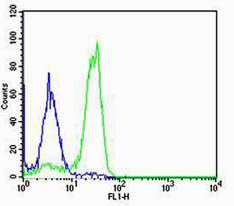产品货号 : mlR10067
英文名称 : SP-C
中文名称 : 肺表面活性蛋白C抗体
别 名 : PSP C; PSPC; Pulmonary surfactant apoprotein 2; pulmonary surfactant apoprotein PSP C; pulmonary surfactant associated protein C; pulmonary surfactant associated proteolipid SPL pVal; Pulmonary surfactant associated proteolipid SPL(Val); SFTP 2; SFTP2; SFTPC; SFTPC surfactant pulmonary associated protein C; SP 5; SP C; SP5; SPC; surfactant associated protein pulmonary 2; Surfactant protein c; Surfactant pulmonary associated protein C; PSPC_HUMAN.
研究领域 : 细胞生物 免疫学 细胞表面分子
抗体来源 : Rabbit
克隆类型 : Polyclonal
交叉反应 : Human, Mouse, Rat, Cow, Rabbit, Sheep,
产品应用 : ELISA=1:500-1000 Flow-Cyt=1μg/Test IF=1:100-500
not yet tested in other applications.
optimal dilutions/concentrations should be determined by the end user.
分 子 量 : 4/21kDa
细胞定位 : 细胞外基质 分泌型蛋白
性 状 : Lyophilized or Liquid
浓 度 : 1mg/ml
免 疫 原 : KLH conjugated synthetic peptide derived from human SP-C:24-58/197
亚 型 : IgG
纯化方法 : affinity purified by Protein A
储 存 液 : 0.01M TBS(pH7.4) with 1% BSA, 0.03% Proclin300 and 50% Glycerol.
保存条件 : Store at -20 °C for one year. Avoid repeated freeze/thaw cycles. The lyophilized antibody is stable at room temperature for at least one month and for greater than a year when kept at -20°C. When reconstituted in sterile pH 7.4 0.01M PBS or diluent of antibody the antibody is stable for at least two weeks at 2-4 °C.
PubMed : PubMed
产品介绍 : This gene encodes the pulmonary-associated surfactant protein C (SPC), an extremely hydrophobic surfactant protein essential for lung function and homeostasis after birth. Pulmonary surfactant is a surface-active lipoprotein complex composed of 90% lipids and 10% proteins which include plasma proteins and apolipoproteins SPA, SPB, SPC and SPD. The surfactant is secreted by the alveolar cells of the lung and maintains the stability of pulmonary tissue by reducing the surface tension of fluids that coat the lung. Multiple mutations in this gene have been identified, which cause pulmonary surfactant metabolism dysfunction type 2, also called pulmonary alveolar proteinosis due to surfactant protein C deficiency, and are associated with interstitial lung disease in older infants, children, and adults. Alternatively spliced transcript variants encoding different protein isoforms have been identified.
Function:
Pulmonary surfactant associated proteins promote alveolar stability by lowering the surface tension at the air-liquid interface in the peripheral air spaces.
Subcellular Location:
Secreted, extracellular space, surface film.
DISEASE:
Defects in SFTPC are the cause of pulmonary surfactant metabolism dysfunction type 2 (SMDP2) [MIM:610913]; also called pulmonary alveolar proteinosis due to surfactant protein C deficiency. A rare disease associated with progressive respiratory insufficiency and lung disease with a variable clinical course, due to impaired surfactant homeostasis. It is characterized by alveolar filling with floccular material that stains positive using the periodic acid-Schiff method and is derived from surfactant phospholipids and protein components. Excessive lipoproteins accumulation in the alveoli results in severe respiratory distress.
Genetic variations in SFTPC are a cause of susceptibility to respiratory distress syndrome in premature infants (RDS) [MIM:267450]; also known as RDS in prematurity. RDS is a lung disease affecting usually premature newborn infants. It is characterized by deficient gas exchange, diffuse atelectasis, high-permeability lung edema and fibrin-rich alveolar deposits called 'hyaline membranes'.
Similarity:
Contains 1 BRICHOS domain.
SWISS:
P11686
Gene ID:
6440
Important Note:
This product as supplied is intended for research use only, not for use in human, therapeutic or diagnostic applications.
产品图片












